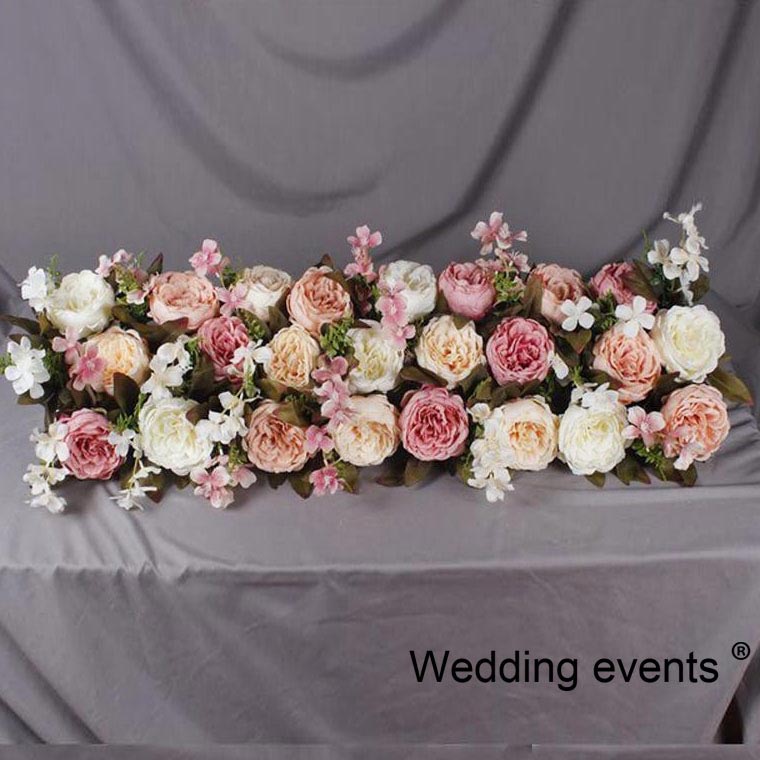A Guide to Artificial Wedding Flowers
Learn everything you need to know about types of artificial flowers, ideas for how to use them, and their pros and cons to decide if they are right for you.

The First Look
- Artificial flowers are stems designed to replicate real flowers, while non-floral bouquets are composed of different elements like seashells, feathers, or tropical leaves.
- Artificial flower alternatives can be more affordable, longer lasting, and offer more flexibility as they come in a variety of forms like silk, foam, paper, and more.
- For bouquets, corsages, centerpieces, or garlands, artificial wedding flowers can cost anything from $20-$300 each depending on the size, number, and type of flowers.
Before we start talking polymers and foams, let’s make the distinction between artificial flowers—individual stems designed to replicate real flowers—and non-floral wedding bouquets.
Artificial Vs. Non-Floral Wedding Flowers
Non-floral bouquets are composed of different, unusual elements that aren’t supposed to look like flowers. Here are some examples of non-floral wedding bouquets:
- Rhinestone “brooch” bouquets
- Seashell bouquets
- “Bauble” bouquets made from holiday ornaments
- All-greenery bouquets, including tropical leaves, ferns, grasses, or herbs
- Fruit or vegetable bouquets
- Succulent or air plant bouquets
- Feather bouquets
- Cotton bouquets
- Paper flower bouquets (see more below)
- Fabric bouquets (see more below)
If you’re going for an alternative approach to your wedding florals, a non-floral bouquet is a great way to add some personalization and creativity to your overall wedding style. Not to mention many non-floral bouquets are more practical for a lot of the same reasons that artificial flowers are: they can be more economical, can be prepared earlier, will last longer, won’t wilt or die in extreme temperatures, and are available regardless of the blooming season.
Pros and Cons of Artificial Wedding Flowers
Pros
- Can be more affordable
- All flower varieties are available in all seasons
- Last Forever
- Greater control over flower types and colors
- Can order and prepare them in advance
- Won’t wilt or attract bugs during outdoor summer weddings
- Good for those with allergies
- Don’t require water, is so easy to transport, and keeps looking good
- Easy to practice (and re-do) any DIY arrangements
Cons
- Can look tacky or cheap
- The best-looking varieties cost as much as (or more than) real flowers
- Lack the same feel as real flowers
- Lack real-floral scent
- Real flowers will always be more breathtaking
Types of Artificial Wedding Flowers
If you think going with artificial wedding flowers cuts down on the number of choices you’ll have to make, guess again: just like non-floral bouquets, there are many types of artificial stems to choose from. This means that their quality and appearance can vary quite a bit—from the often plastic-looking ones you see at the dollar store to incredibly realistic versions that will cost you as much as real flowers. Below you’ll find a description of every type of artificial flower and the pros and cons of each.
“Silk” or Fabric Wedding Flowers
The most familiar type of artificial flowers, these faux blooms are known as silk flowers—however, these days they’re no longer made from silk, but most often a variety of polyester or nylon.
Pros:
- Huge variety of shapes, sizes, colors, and styles
- Widely available
- Easy to mix and match with real blooms
- Slight variations from flower to flower make them look more realistic when nestled together
Cons:
- Edges can fray easily
- Feel very unrealistic to the touch
- Quality varies quite a bit from the seller to seller
- Flower stems are usually thick, steel wires wrapped in plastic, creating a very heavy bundle to hold
Foam Wedding Flowers
These faux blooms are composed of very thin foam petals that are dyed with a specific hue and glued around a styrofoam center. Foam flowers are most often seen as roses, and useful to fill in the center of bouquets and arrangements.
Pros:
- The cheapest artificial flower
- Very lightweight, malleable, and easy to work with
- Look realistic when used to fill in the center of arrangements
Cons:
- Messy and not attractive when seen from the side or underneath
- Sold in packs, rather than individually
- Every flower looks identical, allowing for less realism when placed side-by-side
Wax-Coated Wedding Flowers
Wax-coated artificial flowers are high-quality silk flowers that have been coated with a special wax to make them feel (and look) like real flowers. The level of detail on the petals, such as veining or slight impressions, combined with the real-touch feel make these some of the most expensive artificial flowers available.
Pros:
- Very lifelike and high-quality
Cons:
- Expensive (up to 3 times more than their silk counterparts)
- Since they are still fabric flowers at heart, edges can still fray
Latex Wedding Flowers
Similar to wax-coated flowers, latex artificial flowers are coated in a thin wax and have very lifelike details, making them both look and feel pretty close to the real deal. Latex flower petals are actually made from latex, rather than polyester fabric, so they don’t run the risk of fraying at the edges.
Pros:
- No frayed edges
- Very realistic appearance and feel
- Can be made to mimic thick or thin petals
Cons:
- Lack of variety in flower types
- Hard to find
- Pricey
Fresh Touch (Polymer) Wedding Flowers
The most expensive type of artificial flowers, fresh touch or real touch flowers are designed to look, and feel, as close to the real thing as you can get. They’re made from a blend of foam and latex
Pros:
- Look and feel most like real flowers
- Each flower has slight variations for greater realism when arranged together
Cons:
- Most expensive
- Less readily available (must go through a pro florist)
- White or ivory shades can look aged over time
- Petals can be easily crushed when packed too tightly
Fabric Wedding Flowers
Similar to paper, fabric wedding flowers are on the DIY-approved list if you’re on the artistic side. Fabric flowers are harder to make, however (fabric is less forgiving than paper), and therefore it’s wiser to use fabric flowers in small doses, such as bouquets, boutonnieres, and hair accessories. You can also find fabric wedding bouquets on online craft sites. Satin roses are a common type of fabric wedding flower, as are flowers made from tulle, burlap, felt, cotton, and lace.
If you want to know more about outdoor weddings, please click this: Types of Flatware
